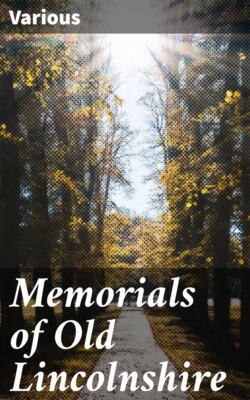Читать книгу Memorials of Old Lincolnshire - Various - Страница 3
На сайте Литреса книга снята с продажи.
PREFACE
ОглавлениеTable of Contents
Lincolnshire, perhaps, is known most widely as the second largest county in England, as pre-eminent in agriculture and stock-breeding on wold, heath, marsh, and fen, as well to the fore in the manufacture of agricultural and other machinery, as possessing the largest fishing-port in Europe (Grimsby), and as being associated with “The Handicap.”
But, apart from all these, she can boast of very many attractions for the traveller and the antiquary. Flat and low though her shores may be, yet there is a fascination in the great extent of “yellow sands”; and there is a recompense for the level plain of marsh or fen in the vast expanse of sky, where “The incomparable pomp of eve, And the cold glories of the dawn,” are seen at their finest.
And the views are wonderful: from Alkborough, over the junction of the Trent, the Ouse, and the Humber; from Lincoln, over the plateau eastwards to the wolds, or westwards over the valley of the Trent to the Nottinghamshire and Derbyshire hills; or eastwards, from the edge of the “high wold,” over the great plain
“That sweeps with all its autumn bowers,
And crowded farms and lessening towers,
To mingle with the bounding main.”
The county possesses the birthplaces of Newton, Tennyson, Henry of Bolingbroke, Archbishop Whitgift, and John Wesley. She has produced explorers like Franklin, and heroes of romance and reality like Sir John Bolles (the hero of the Spanish Lady ballad) and Captain John Smith of Willoughby (who was rescued by Pocahontas). St. Botolph, St. Guthlac, and St. Gilbert of Sempringham were all Lincolnshire in origin and life, and the latter founded the only monastic order (that of the Gilbertines) which originated in this country.
The monastic institutions of this county have had to be passed by in this volume. Although there are no vast or splendid remains (if Thornton Abbey gate-house and Crowland be excepted) above ground, still the excavations of the Rev. C. G. Laing at Bardney Abbey have proved how large and beautiful one at least of those buildings was.
The city of Lincoln, again, demanding a volume to itself, has not been dealt with here, save in so far as it appears in Roman times.
The greatest and noblest “memorial” of all is, of course, the mighty Minster, superb in its architecture and in its situation, with its great roll of bishops from St. Hugh and Grosseteste to Christopher Wordsworth and the much beloved, most saintly, Edward King. But this subject could not be treated of piecemeal, and has been deliberately omitted.
But Lincolnshire is particularly rich in splendid and interesting churches, and much will be found in this volume to justify these epithets.
Stamford, Boston, and Grantham all have had full justice done to them, while Tattershall Castle may well serve as a specimen of the best domestic building of the time of King Henry VI., as Doddington does of “the spacious times of great Elizabeth.”
The history of the county has been interesting, and at times very important. The wars of King Stephen, the battle of “Lincoln Fair,” the Lincolnshire rising in 1470, and the second insurrection in 1536 at the suppression of the monasteries, have had to be passed over; but the pre-historic facts, those of the Roman rule, and of the great Civil War will be found.
To the Rev. P. H. Ditchfield, the General Editor of this series, and to the Rev. G. E. Jeans, whose knowledge of Lincolnshire is unequalled, for much kind help and advice; to all my contributors, and to all who have given photographs or illustrations, I desire to tender my most sincere thanks.
E. Mansel Sympson.
Deloraine Court, Lincoln,
November 1910.
Note.—As the County of Lincoln possesses no heraldic bearings, the Lord Bishop has kindly permitted the use of the coat-of-arms of the See of Lincoln to be used on the cover of this volume.
